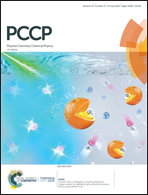Reversible two-channel mechanochromic luminescence for a pyridinium-based white-light emitter with room-temperature fluorescence–phosphorescence dual emission†
Abstract
Organic mechanochromic luminescent (ML) materials have attracted extensive interest due to their potential uses in displays, sensing, bioimaging and data storage. ML materials that distinctively respond to different mechanical stimuli are especially fascinating. A simple pyridinium-based white-light emitter (P1-PF6) exhibiting this sort of ML with room-temperature fluorescence–phosphorescence dual emission (rFPDE) was found to possess a 3.66% quantum yield. Interestingly, mechanical grinding induced phosphorescence disappearance owing to a collapse of the crystalline ordering. Grinding followed by adding a drop of ethanol resulted in an extraordinary tricolor emission switching between white, blue and pinkish orange. More interestingly, mechanical pressing induced phosphorescence enhancement, resulting in the emission color changing from white to pinkish orange. This novel phenomenon may be due to the fact that pressure facilitates a closer arrangement between adjacent molecules, thereby enhancing the intermolecular interactions. In sum, a very scarce example is herein reported. Moreover, because the pure organic pyridinium with rFPDE achieves reversible two-channel ML over a wide wavelength range, this material has potential applications in multi-dimensional sensors.



 Please wait while we load your content...
Please wait while we load your content...